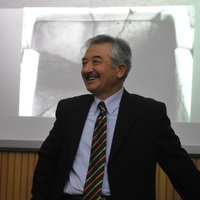
Aliye Erol
Address: İstanbul Üniversitesi Edebiyat Fakültesi Tarih Bölümü Eskiçağ Tarihi Anabilim Dalı
4. Kat, A blok, ofis no.20
34459 Laleli-İSTANBUL
Email: aliyeerol@gmail.com, aliyerol@istanbul.edu.tr
4. Kat, A blok, ofis no.20
34459 Laleli-İSTANBUL
Email: aliyeerol@gmail.com, aliyerol@istanbul.edu.tr
less
Related Authors
Ersin Bakış
Istanbul University
Murat Aydın
Uludag University
Sinem Güzel Yıldırım
Istanbul University
Mesut Ceylan
Ataturk University
nujin gürbey
Mimar Sinan Fine Arts University
Merve Sarılar-Özdemir
Karamanoglu Mehmetbey University
Hüseyin Köker
Suleyman Demirel University
Evin Bilge
Gaziosmanpasa University
InterestsView All (26)









Uploads
Books by Aliye Erol
Papers by Aliye Erol
This paper evaluates the festivals held in Byzantium (modern Istanbul) during the Roman Imperial Period, in whose programs various games/competitions were included. These games, called agon, which were organized by the Greek cities under the Roman rule partly to fulfill their political or religious duties and partly to maintain their Greek identities, can be determined thoroughly from the epigraphic and numismatic evidence. Byzantium’s most important agonistic organization, as understood from its coins and inscriptions, began with the name “Antonineia Sebasta" as a sign of loyalty and gratitude of the people of Byzantium to emperor Caracalla. The agons, which were held in honour of emperors, continued in Byzantium after Caracalla’s reign. The names of athletes, gymnasiarkhoi and agonothetai; the categories of the contests, and prizes were mentioned in the epigraphical sources related to these agons. A festival calendar can also even be reconstructed in the light of numismatic evidence. Furthermore, it is understood from the coins that the term ‘Antoninia’ is not an adjective of the city, but rather the names of the agones. The name was used on coins only with the agonistic types. Besides that, the Bosporia, whose origin dates back to pre-Roman times, festivals of Dionysos Kallon thiasos and Zeus Pratomysios in the Byzantium territorium, were among the agones of Byzantium during the Roman Imperial period.
This paper evaluates the festivals held in Byzantium (modern Istanbul) during the Roman Imperial Period, in whose programs various games/competitions were included. These games, called agon, which were organized by the Greek cities under the Roman rule partly to fulfill their political or religious duties and partly to maintain their Greek identities, can be determined thoroughly from the epigraphic and numismatic evidence. Byzantium’s most important agonistic organization, as understood from its coins and inscriptions, began with the name “Antonineia Sebasta" as a sign of loyalty and gratitude of the people of Byzantium to emperor Caracalla. The agons, which were held in honour of emperors, continued in Byzantium after Caracalla’s reign. The names of athletes, gymnasiarkhoi and agonothetai; the categories of the contests, and prizes were mentioned in the epigraphical sources related to these agons. A festival calendar can also even be reconstructed in the light of numismatic evidence. Furthermore, it is understood from the coins that the term ‘Antoninia’ is not an adjective of the city, but rather the names of the agones. The name was used on coins only with the agonistic types. Besides that, the Bosporia, whose origin dates back to pre-Roman times, festivals of Dionysos Kallon thiasos and Zeus Pratomysios in the Byzantium territorium, were among the agones of Byzantium during the Roman Imperial period.